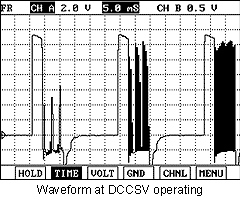

The TCM controls the locking and unlocking of the Torque Converter Clutch ( or Damper Clutch ), to the input shaft of the transmission, by appling hydraulic pressure. The main purpose of T/C clutch control is to save the fuel by decreasing the hydraulic load inside the T/C. The TCM outputs duty pulses to control the Damper Clutch Control Solenoid Valve( DCCSV ) and hydraulic pressure is applied to DC according to the DCC duty ratio value. When the duty ratio is high, high pressure is applied and the Damper Clutch is locked. The normal operating range of the Damper Clutch Control duty ratio value is from 30%(unlocked) to 85%(locked).
The TCM checks the Damper Clutch Control Signal by monitoring the feedback signal from the solenoid valve drive circuit. If an unexpected signal is monitored, (For example, high voltage is detected when low voltage is expected, or low voltage is detected when high voltage is expected) the TCM judges that the DCCSV circuit is malfunctioning and sets this code.
Item | Detecting Condition & Limp Home | Possible Cause |
DTC Strategy | ● Proper functional response and circuit continuity | ● Check line open and short between PCM C33-2 terminal 37 and A/T solenoid C04 terminal 1 ● Check for DCCSV-B faulty ● Check PCM faulty. |
Enable Conditions | ● None | |
Threshold Value | ● Solenoid is turned on and circuit is short ● Solenoid is turned off and circuit is open | |
Diagnostic Time | ● More than 0.3sec | |
Fail Safe | ● 3rd HOLD in D RANGE, 2nd HOLD in 2,L RANGE |
